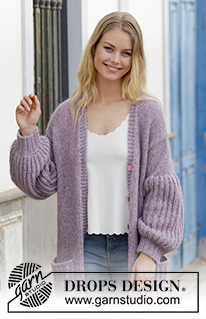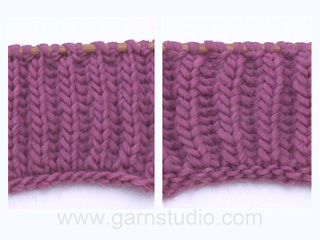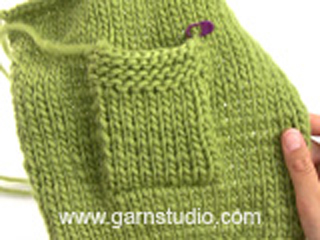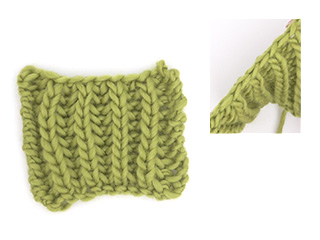Wayfarer |
|
 |
 |
Knitted jacket with English rib, stockinette stitch and pockets. Sizes S - XXXL. The piece is worked in DROPS Air.
DROPS 191-18 |
|
|
INFORMATION FOR THE PATTERN: RIDGE/GARTER STITCH (worked back and forth): 1 ridge = Knit 2 rows. ENGLISH RIB (back and forth on needle, including 1 edge stitch in each side): ROW 1: 1 stitch garter stitch, * knit 1, 1 yarn over, slip 1 stitch as if to purl *, work from *-* until there are 2 stitches left, finish with knit 1, 1 stitch garter stitch. ROW 2: 1 stitch garter stitch, * 1 yarn over, slip 1 stitch as if to purl, knit the yarn over and the slipped stitch together *, work from *-* until there are 2 stitches left, finish with 1 yarn over, slip 1 stitch as if to purl, 1 stitch garter stitch. ROW 3: 1 stitch garter stitch, * knit the yarn over and the slipped stitch together, 1 yarn over, slip 1 stitch as if to purl *, work from *-* until there are 3 stitches left, knit the yarn over and slipped stitch together, 1 stitch garter stitch. Repeat rows 2 and 3 upwards. DECREASE TIP -1 (= for the sides): All decreases are made from the right side! At the beginning of the row: Decrease 1 stitch after 2 stitches as follows: Slip 1 stitch as if to knit, knit 1, pass the slipped stitch over (= 1 stitch decreased). At the end of the row: Decrease 1 stitch before 2 stitches as follows: Knit 2 together (= 1 stitch decreased). DECREASE TIP -2 (for neck): All decreases are made from the right side! Decrease 1 stitch after the 5 band stitches as follows (applies to right front piece): Work 5 band stitches in garter stitch, slip 1 stitch as if to knit, knit 1, pass the slipped stitch over (= 1 stitch decreased). Decrease 1 stitch before the 5 band stitches as follows (applies to left front piece): Work until there are 7 stitches left, knit 2 together (= 1 stitch decreased), work 5 band stitches in garter stitch. BUTTONHOLES: Work buttonholes on the right band. 1 BUTTONHOLE = knit together the 3rd and 4th stitch from the edge and make 1 yarn over. On the next row knit the yarn over = hole. Work buttonholes when the piece measures: S: 14, 22, 31, 40, 49 and 58 cm M: 14, 23, 32, 41, 50 and 60 cm L: 14, 23, 32, 42, 52 and 62 cm XL: 14, 24, 34, 44, 54 and 64 cm XXL: 14, 24, 34, 44, 54 and 65 cm XXXL: 14, 24, 34, 45, 56 and 67 cm INCREASE TIP: (for sleeves) Increase by making 1 yarn over between 2 stitches; on the next row from the wrong side purl the yarn over twisted to avoid a hole. ---------------------------------------------------------- JACKET: The jacket is worked back and forth with circular needle, bottom up. The back piece and front pieces are worked separately and sewn together to finish. Then the sleeves are worked and sewn to the body. BACK PIECE: The piece is worked back and forth with circular needle. Cast on 81-84-90-99-105-114 stitches with circular needle size 7 mm / US 10.75 and Air. Work 4 stitches garter stitch, * knit 1, purl 2 *, work from *-* until there are 5 stitches left, finish with knit 1 and 4 stitches garter stitch. Work 6 rows like this. Then continue in stockinette stitch with 4 stitches garter stitch in each side, AT THE SAME TIME on the first row of stockinette stitch adjust the number of stitches to 80-84-90-98-106-114 stitches. REMEMBER THE GAUGE! When the piece measures 14 cm / 5½'' cast on 1 edge stitch at the end of the next 2 rows (= 1 new stitch in each side of the piece) = 82-86-92-100-108-116 stitches. Then continue working stockinette stitch with 1 edge stitch in garter stitch in each side of the piece. When the piece measures 15 cm / 6'' decrease 1 stitch inside the 2 stitches in each side of the piece – read DECREASE TIP-1 = 2 stitches decreased. Decrease like this every 8-8-8½-9-9½-10 cm / 4'' a total of 6 times = 70-74-80-88-96-104 stitches. When the piece measures 58-60-62-64-66-68 cm / 22¾''-23 5/8''-24 3/8''-25¼''-26''-26¾'' bind off 3-4-4-5-5-6 stitches for the armholes at the start of the next 2 rows = 64-66-72-78-86-92 stitches. Then bind off 1 stitch in each side every 2nd row a total of 0-0-1-3-5-7 times = 64-66-70-72-76-78 stitches. When the piece measures 75-78-81-84-87-90 cm / 29 ½"-30 5/8"-31 7/8"-33"-34 ¼"-35 3/8" bind off the middle 16-18-20-20-22-22 stitches for neck = 24-24-25-26-27-28 stitches left on each shoulder. Then bind off stitches for diagonal shoulders at the beginning of each row towards the neck - i.e. at the beginning of each row from the right side on the right shoulder (when the garment is worn) and the beginning of each row from the wrong side on the left shoulder (when the garment is worn). Bind off for diagonal shoulders as follows: 6 stitches 3 times, then bind off the remaining 6-6-7-8-9-10 stitches. Repeat on the other side. The piece measures a total of 79-82-85-88-91-94 cm / 31''-32¼''-33½''-34 5/8''-35¾''-37''. RIGHT FRONT PIECE: Cast on 46-49-49-55-58-61 stitches (including 5 band stitches) with circular needle size 7 mm / US 10.75 and Air. Work as follows from the right side: 5 band stitches in garter stitch, * knit 1, purl 2 *, work from *-* until there are 5 stitches left, finish with knit 1 and 4 stitches in garter stitch. Work 6 rows like this. Then continue working from the right side as follows: 5 band stitches in garter stitch, work stockinette stitch until there are 4 stitches left, finish with 4 stitches in garter stitch, AT THE SAME TIME on the first row of stockinette stitch adjust the number of stitches to 45-47-50-54-58-62 stitches. When the piece measures 14 cm / 5½'', adjust to match the back piece, cast on 1 edge stitch at the end of the next row from the right side = 46-48-51-55-59-63 stitches. Then continue with stockinette stitch and 5 band stitches in garter stitch towards mid front as before and 1 edge stitch in garter stitch towards the side. Work BUTTONHOLES on the band – see description above. When the piece measures 15 cm / 6'', decrease 1 stitch inside the 2 stitches in the side at the end of the next row from the right side. Decrease like this every 8-8-8½-9-9½-10 cm / 4'' a total of 6 times = 40-42-45-49-53-57 stitches. When the piece measures 58-60-62-64-66-68 cm / 22¾''-23 5/8''-24 3/8''-25¼''-26''-26¾'' bind off for the armhole in the side as for the back piece = 37-38-40-41-43-44 stitches. AT THE SAME TIME when the piece measures 59-61-63-65-66-68 cm / 23 1/8"-24"-24 ¾"-25 ½"-26"-26 ¾" decrease for the neck inside the 5 band stitches – read DECREASE TIP-2. Decrease like this every 4th row a total of 8-9-10-10-11-11 times = 29-29-30-31-32-33 stitches left when the neck decreases are finished. When the piece measures 75-78-81-84-87-90 cm / 29 ½"-30 5/8"-31 7/8"-33"-34 ¼"-35 3/8" bind off for diagonal shoulder at the beginning of each row from the wrong side as follows: 6 stitches 3 times, 6-6-7-8-9-10 stitches 1 time = 5 band stitches left on the needle. Work garter stitch over the band stitches until the band measures approx. 10-11-11-12-13-13 cm / 3 7/8"-4 ¼"-4 ¼"-4 5/8"-5 1/8"-5 1/8" from the last bind off stitch on the shoulder (this will be sewn to the neck on the back piece). LEFT FRONT PIECE: Work as for the right front piece but reversed. Do not work buttonholes. SLEEVES: The sleeves are worked back and forth with circular needle. Cast on 44-47-47-50-50-53 stitches (including 1 edge stitch in each side of the piece) with circular needle size 4 mm / US 6 and Air. Work rib (= knit 1, purl 2) with 1 edge stitch in garter stitch in each side of the piece. When the rib measures 7-7-7-7-7-7 cm / 2 ¾"-2 ¾"-2 ¾"-2 ¾"-2 ¾"-2 ¾", adjust so that the next row is worked from the right side, work 1 row of rib as before AT THE SAME TIME as you increase 11-12-12-13-13-14 stitches evenly on row – read INCREASE TIP! = 55-59-59-63-63-67 stitches. Purl 1 row. Change to circular needle size 7 mm / US 10.75 and work ENGLISH RIB – see description above. Continue until the piece measures 37-37-37-37-37-37 cm / 14 ½"-14 ½"-14 ½"-14 ½"-14 ½"-14 ½" and then continue with stockinette stitch with 1 edge stitch in garter stitch in each side of the piece AT THE SAME TIME as you decrease 8-9-6-7-4-6 stitches evenly on the first row = 47-50-53-56-59-61 stitches. Continue with stockinette stitch until the piece measures 45-45-45-45-45-45 cm / 17 5/8"-17 5/8"-17 5/8"-17 5/8"-17 5/8"-17 5/8". Now bind off 4 stitches in each side, bind off in each side every 2nd row a total of 4 times = 15-18-21-24-27-29 stitches. Bind off the remaining stitches, the sleeve measures 50-50-50-50-50-50 cm / 19 5/8"-19 5/8"-19 5/8"-19 5/8"-19 5/8"-19 5/8". Work the other sleeve in the same way. POCKETS: Cast on 25 stitches with circular needle size 7 mm / US 10.75 and Air. Work 2 ridges then work ENGLISH RIB with 1 stitch in garter stitch in each side. When the piece measures 16 cm work 1 ridge, then bind off. Work one more pocket in the same way. ASSEMBLY: Sew the side seams inside the 1 edge stitch in garter stitch, sew down to the split (= 14 cm / 5½'' split). Sew shoulder seams and sew the neck from the front pieces together and sew it to the neck on the back piece. Sew the sleeve seams inside the 1 edge stitch in each side, then sew the sleeves to the body. Sew buttons onto the left band. Sew a pocket onto each front piece – approx. 14 cm / 5½'' from the bottom edge and 8 cm / 3 1/8'' from mid front – see photo. |
|

|
|
|
Have you made this or any other of our designs? Tag your pictures in social media with #dropsdesign so we can see them! Do you need help with this pattern?You'll find tutorial videos, a Comments/Questions area and more by visiting the pattern on garnstudio.com. © 1982-2024 DROPS Design A/S. We reserve all rights. This document, including all its sub-sections, has copyrights. Read more about what you can do with our patterns at the bottom of each pattern on our site. |
|
































































Comments / Questions (55)
Bij het achterpand moet je na 58 cm aan beide kanten 3 steken afkanten. Moet je vervolgens weer doorbreien in patroon met steeds een rechte steek als kantsteek? Of vervalt deze rechte steek na het afkanten?
27.12.2023 - 19:28DROPS Design answered:
Dag Moniek,
Je breit, na het minderen voor de armsgaten, nog steeds kantsteken aan beide kanten.
31.12.2023 - 13:59Det må være feil i antall masker på forstykkene ved ermhullsfelling. Dersom man skal felle likt som på bakstykket (5 masker i hver side), altså kun 5 masker i én side på forstykkene har man 48 masker igjen på pinnen. I oppskriften står det 43. Da får man for mange masker igjen etter alle fellingene til hals og skrå skulder. Hvordan best løse dette?
06.04.2023 - 11:45Bonjour ! Quand l'ouvrage mesure 15 cm, diminuer 1 maille à 2 mailles du bord de chaque côté.... Question : c'est bien dans les mailes de la bordure en point mousse la diminution ou dans le Jersey ? Merci !
11.02.2023 - 05:39DROPS Design answered:
Bonjour Isabelle, on diminue pour le dos de chaque côté mais pour les devants, on ne diminue que d'un seul côté (le côté couture au dos, pas le côté bordure devant) - ces diminutions se font à 2 mailles du bord, soit 1 m lisière au point mousse + 1 m jersey. Bon tricot!
13.02.2023 - 11:06Buongiorno, quindi la parte di chiusura del retro collo una volta cucita al davanti, resta chiusa semplicemente senza bordo? sarebbe stato molto pratico vedere una foto vista dal dietro. Grazie per l'aiuto
14.01.2023 - 12:15DROPS Design answered:
Buonasera Laura, il collo viene prima cucito insieme e poi attaccato alla scollatura. Buon lavoro!
16.01.2023 - 22:24Kan je de mouwen helemaal in patentsteek breien of is er een reden om de laatste rijen in tricotsteken te breien ?
27.10.2022 - 18:15DROPS Design answered:
Dag Katleen,
Zo is het ontwerp bedacht, dus dat het laatste stukje in tricotsteek gebreid wordt. Als je het mooier vindt om de mouwen in zijn geheel in patentsteek te hebben, dan kun je dat natuurlijk ook doen.
27.10.2022 - 20:55Può essere realizzato con il filato sky?
25.09.2022 - 15:33DROPS Design answered:
Buongiorno Rita, questo modello si lavora con un filato del gruppo C o 2 capi del gruppo A. Sky appartiene al gruppo B, quindi ha una consistenza diversa rispetto al filato consigliato. Buon lavoro!
26.09.2022 - 17:08Hallo, wieviele Zentimeter sollen am Ärmel in Vollpatent in Größe M gestrickt werden?
04.09.2022 - 15:41DROPS Design answered:
Liebe Antje, es sind 7 cm Bündchen + 30 cm Volltpatent = nach 37 cm stricken Sie glatt rechts. Viel Spaß beim stricken!
05.09.2022 - 09:23Voor het achterpand staat bij voor het armsgat dit “Als het werk 58-60-62-64-66-68 cm meet, kant dan 3-4-4-5-5-6 steken af voor de armsgaten op het begin van de volgende 2 naalden = 64-66-72-78-86-92 steken”. Dus bij de kleinste maat 2x3 steken. Bij het voorpand wordt verwezen naar het achterpand maar volgens het aantal steken wordt daar maar 1x geminderd. Klopt dit? Groet Renate
03.07.2022 - 20:53DROPS Design answered:
Dag Renate,
Je kant inderdaad 3 steken af aan het begin van de volgende twee naalden, dus de heengaande naald 3 steken afkanten en de teruggaande naald 3 steken afkanten. In totaal heb je dan 6 steken minder op de naald. Dit geldt voor zowel het voorpand als het achterpand.
08.07.2022 - 08:53Buongiorno! Vorrei usare il filato big merino. Per realizzare questo Cardigan, devo usare lo stesso i ferri n 7? Grazie
04.05.2022 - 12:47DROPS Design answered:
Buonasera Francesca, Big Merino appartiene allo stesso gruppo filati di Air, quindi può seguire le stesse spiegazioni controllando che il suo campione corrisponda a quello indicato. Buon lavoro!
07.05.2022 - 17:19ACHTERPAND: “Het werk wordt heen en weer gebreid met de rondbreinaald. Zet 81-84-90-99-105-114 steken op met rondbreinaald 7 mm en Air. Brei 4 steken ribbelsteek, * 1 recht, 2 averecht *, brei van *-* tot er 5 steken over zijn, eindig met 1 recht en 4 steken ribbelsteek. Brei zo 6 naalden. “ In Naald 2 , 4 en 6 - brei ik dan *1 averecht, 2 recht* en in naald 1, 3 en 5 *1 recht, 2 averecht *? Of brei ik in elk van de 6 naalden *1 recht 2 averecht*?
25.04.2022 - 15:23DROPS Design answered:
Dag Cen10a,
Aan de verkeerde kant brei je de boordsteek andersom, dus waar je aan de goede kant recht breit, brei je aan de verkeerde kant averecht en waar je aan de goede kant averecht breit, brei je aan de verkeerde kant recht.
28.04.2022 - 09:45